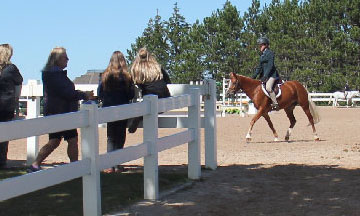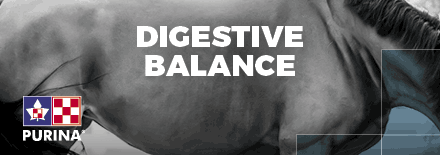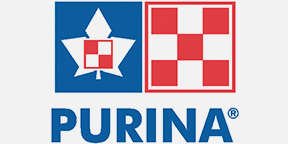By: Kalina Rutledge, BBRM Equine & Marc-Andre Blouin, B.Sc.
Almost every horse owner has experienced it. You walk into the barn for night check, peer into a stall and find your horse sweating, kicking at his stomach and trying to lie down and roll. As a horse owner we know the drill, this now means a sleepless night of walking endless circles with a horse that just wants to collapse while you await your veterinarian’s return call.
Colic is something that we as horse owners are always working to prevent. Horses are unfortunately equipped with an extremely sensitive digestive system, which requires careful management in order to keep everything working properly and keep your horse healthy. Bear in mind, the majority of this sensitivity has occurred because of domestication. There can be many reasons for colic in a horse. Stress, long-term use of some medications, parasites and intake of foreign objects can be some causes of colic. However, in most cases, colic can be linked to five main factors, all of which can be attributed to the struggle between our current domestication practices and the horse’s natural diet when living in the wild.
First of all, horses are not equipped with the reflex to vomit. Therefore, if they eat something that does not agree with them, their stomach would literally explode instead of being able to vomit. Secondly, the majority of a horse’s digestive processes rely on bacteria to break down feed. As a result, if a diet changes drastically over a short period this affects the bacterial population and can cause upset in the gut that can lead to colic and laminitis. Thirdly, horses have evolved to eat pasture, which consists of about 70 per cent water compared to the 10 per cent water in hay.
Also, hay is coarser than grass, requiring greater retention time within the gut in order to digest this coarser fiber. These two reasons combine to make hay a lot harder to push through the digestive system, hence the term hay belly. Fourthly, horses have evolved consuming a slow continual intake of a low starch, high-fiber diet. Through domestication, the original diet of high calorie pasture has declined, being replaced by low-calorie hay. This, in addition to the greater caloric demand from athletic performance, has necessitated an increase in the consumption of starch in the form of grains.
In addition to this already drastic change, the starch is fed in meals, often two to three times per day instead of the ideal slow, continual intake throughout the day.
Finally, the fifth factor related to colic is that horses have evolved to graze for their meals. Grazing involves moving around in search of what they eat. In the wild a horse would travel hundreds of miles grazing. This constant movement, even though slow, promotes gut motility and keeps the digestive system functioning properly.
A bout of colic can be the result of only one of these main factors but usually a cumulative combination of two or more of the above factors are to blame. This is why a comprehensive management strategy can be the best option to help prevent colic.
As winter approaches for Canadians, the most common type of colic is impaction colic. Impaction colic occurs when there is a blockage in the intestine. The main culprit of impaction colic is dehydration, or more accurately a water deficit in the hindgut. Something that horse owners often don’t consider enough with changing weather is the change in forage and, subsequently, water intake. Water in pasture helps to keep your horse’s digestive system moving properly. Once feeding hay, your horse is suddenly consuming significantly less water in its forage source and will now have to drink 10 gallons of water to make up for this moisture loss. That is two buckets just to bring hay to the moisture level of pasture. A lot of horses choose not to drink this much extra water. Adding to the problem is the drop in air and water temperature, further suppressing the horse’s desire to drink.
Now, think of the above five main factors and how many are combining here to create a bad situation. A horse switching from easily digestible grass to coarse hay will have slower gut motility and loss of water intake. While consuming hay the horse is now standing in one place instead of constantly moving when grazing, again compromising gut motility. Finally, due to the colder weather, the horse will be consuming more hay to meet the increased caloric requirement, provoking a further water demand. A horse in this situation is a prime candidate for impaction colic.
This is the outcome for many people, especially going into the colder months but it doesn’t have to be. This type of colic is completely preventable with proper feeding and management. One of the most important factors here is that your horse needs to stay hydrated in order to have enough moisture in its gut. Sometimes looking at the manure is the best indicator of moisture in the gut.
Many people think it is healthy to see hard balls of manure but that is actually a negative product of domestication. To ensure that there is sufficient moisture in the gut, a ball of manure should squish under your foot with excess water when stepped on. If this doesn’t happen your horse needs to drink more. You may think your horse will drink if it needs water but the truth is it won’t. Hence the old saying, “You can lead a horse to water but you can’t make him drink.” The biggest factor that prevents your horse from drinking enough, especially during the colder months, is temperature. Once water becomes too cold your horse would prefer not to drink and with a drop in air temperature their thirst is suppressed. Your goal is to find a way to make your horse drink despite the cold.
Sodium chloride is your most basic and important electrolyte. You know it as plain white salt. It is cheap and easy to find; go to your feed store and order a 50lb bag of plain white salt, it will last months. The salt lick hanging in your stall is not a sufficient source of salt for most horses. It was made for a cow that has a rough tongue and salivates easily to lick those hard blocks. Horses often prefer to use them as a scratching post. Adding loose salt to your horse’s feed is the way to make him drink. Think of how thirsty you get when you eat a bag of potato chips; it’s the same for your horse. Either add loose salt into their feed or mix a couple tablespoons of salt with apple sauce in a syringe and squirt the paste into their mouth so they can’t spit it out.
The other important factor when giving your horse salt to promote drinking is that they need to have access to fresh, clean water at all times, in their stall and during turnout. Another way to help get extra water into your horse is to wet their feed. Everyone thinks of a warm mash during cold winter months but why not wet your feed all the time? It’s just another chance to get more water into your horse, help any supplements stick and it will dissolve the salt you now add. You don’t have to add any special ingredients to make a mash, just use the feed you use now. Most feeds with at least 15% fiber make beautiful mashes by simply adding water.
Colic can be a scary situation for horse owners, but steps can be taken to minimize your horse’s risk. The key to preventing colic is to understand the potential causes so that you don’t put your horse in that situation. Remember those five main factors and evaluate your overall management program to see if there are any areas to improve upon. Proper management is the key to keeping your horse healthy and happy.
Have a question you need answered or a subject you’d like to see covered? Email Kalina Rutledge at Kalinar@agribrands.ca










